Syrtis Major, Mare Tyrrhenum, Mare Cimmerium and
Mare Sirenum
|
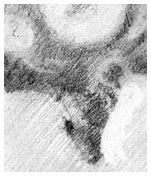 Syrtis Major
Syrtis Major
(Misch, 2003) |
The Great Bog was a magnificent continental land-mass in the Great Telescope.
Its basalt-covered plateau appeared windswept and mottled. There were dark
kernels especially along the neck of the Syrtis, including a large blackish
mass around the cone of the shield volcano itself. The dark-filled Huygens
crater was always visible. Sheehan saw Hellas as a dull grayish mass; brighter
in its southern part, a delicate swirl-like pattern in its northern part that
at times almost resembled a spiral. To Misch, it presented a broad plain
enclosed by a nearly circular dark ring, looking at times like some huge
ornament crowning the forehead of Syrtis Major.
In views reminding us of - and perhaps suggested by - Antoniadi's great six
hours of perfect seeing with the Great Meudon Telescope on September 20, 1909,
Mare Tyrrhenum sometimes broke into a leopard-skin pattern of spots. Mare
Cimmerium and Mare Sirenum on the other hand appeared streaky in texture -
recalling Barnard's comment that the planet looked as if it had been painted
with a bad brush. |
|
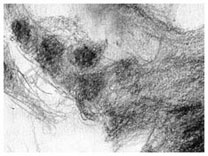 Mare Tyrrhemnum
Mare Tyrrhemnum
(Sheehan, 2003) |
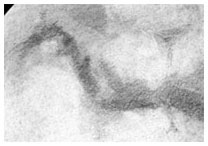 Mare Sirenum & Mare Cimmerium
Mare Sirenum & Mare Cimmerium
(Misch, 2003) |
|
Margaritifer Sinus, Sinus Meridiani, Sinus Sabaeus
|
|
These views were dominated by the elegantly curving Sinus Sabaeus, which
looked like a serpentine ribbon drawn across the disk. In the best seeing,
the outline became ragged, and the bright-floored crater Schiaparelli,
corresponding to the classical region Edom, was notable.
For Misch, this region was the most readily captured on paper.
"The assertive curve of Sabaeus, with its clawed end, reaching far across the
planet just south of the equator, provided a strong anchor for the eye,
a frame of reference against which subtler features could be gauged." |
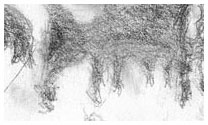 Margaritifer Sinus to Aurora Sinus
Margaritifer Sinus to Aurora Sinus
(Sheehan, 2003) |
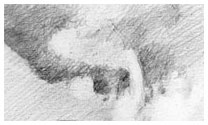 Sinus Sabaeus & Margaritifer Sinus
Sinus Sabaeus & Margaritifer Sinus
(Misch, 2003) |
|
The northern border of the dark region running from Margaritifer Sinus to
Aurorae Sinus, with all its windswept projections, appeared lighter and lower
contrast in comparison with the region south of it. A broad dusky field
crossed a broad expanse lying northward of Margaritifer Sinus and Meridiani
Sinus, appearing to one of us (Sheehan) to be a lava-flooded area - its
outline was lobular, and suggestive of flow. This was a region which some of
the classical observers covered with canals. The wide southern expanse beyond
Meridiani Sinus and Margaritifer Sinus, on the other hand, including the
ancient and channel-dissected region of Noachis, consisted of a rather
difficult to apprehend area of subtle light and dark patches. |
|
Valles Marineris region and Tharsis
|
|
We expended much effort in attempting to define the structure at the complex
intersection where Mare Erythraeum - Coprates - and Aurorae Sinus come
together, around the irregular brightish patch Schiaparelli named Capri Cornu.
The Coprates - Tithonius Lacus region broke up into tiny fissures, flecks,
and spots, the "gingerbread principalities" of the Martian domain and
corresponding to structures along the Valles Marineris canyon system.
Sheehan reported that "at times Coprates itself appeared to be accompanied by
very faint etched linear structures running alongside and parallel to it.
All of the desert regions, when seen under steady conditions, were covered
with bright knots, pale streaks, and other features. It was easy to see how
William H. Pickering could have believed he had discovered forty lakes in the
Solis Lacus region." Misch's drawings, while showing many of the same features,
stop short of some of the finest detail hinted at in Sheehan's.
Nevertheless, the wealth of detail is hardly surprising, since we now know
that the whole region contains some of the most extraordinary topographic
features on the surface of Mars. The huge domical swell of lavas in the
Tharsis region measures 3,000 kilometers across and contains the towering
Tharsis shield volcanoes. The uplift in this region has fractured the
Martian crust into the famous Valles Marineris canyon complex, which
"points like an accusing finger from the heart of Tharsis" (Hartmann,
A Traveler's Guide to Mars). (Note that when making his drawings, Misch was
innocent of these topographic facts.)
In good seeing the Valles Marineris showed extraordinary structure in the
Tithonius Lacus/Noctus Labyrinthus region. Except Olympus Mons, which
appeared as a bright patch, the Tharsis shield volcanoes were not definitely
seen. Thus, the appearance of the Tharis region was very different from that
shown in Barnard's drawings of 1894, where they were recorded as large dusky
spots. The latter is the characteristic appearance when fresh bright dust
has been stirred up, increasing contrast between the background and the dusky
tops of the volcanoes poking through it. Once the dust settles, the contrast
between volcanoes and the surround decreases and the magnificent mountains
camouflage themselves into the background.
There are a number of features recorded in these drawings whose significance
was not known to Barnard and other visual observers of the 19th century but
are now identified as impact features. A number - but not all - of the tiny
spots along the margin of Mare Erythraeum correspond to craters whose
interiors are filled with coarse dust. The Argyre basin was always visible
to us as a diffuse patch in southern Mare Erythraeum. Some of the irregular
features in the south polar cap's outline, which early observers believed to
be mountains, are actually depressed areas associated with a large impact
basin that straddles the south pole of the planet.
One of us (Sheehan) sometimes had impressions of "canals" in this region,
or features that were interpreted as such by some observers. Notably, the
boundaries of the bright streak that passes between Juventae Fons and
Coprates-Tithonius Lacus, in the desert region known as Xanthe, appeared in
coarse views as a double canal. However careful attention always
revealed its true nature as a stretch of lighter soil projected against
a duskier background. |
|
Solis Lacus
|
|
The early observers knew Solis Lacus as the "Oculus," or Eye of Mars, but
their description hails from a time when the feature was round in shape
and set in the midst of a quite regularly oval-shaped bright background.
In fact, Solis Lacus occupies one of the most windblown - and thus most
variable - parts of the planet. The dark embayment around the "Eye" often
seemed to us sharply defined, and looked as if its margin had been traced
with eyeliner; at times, when the seeing became steadiest, this boundary
broke intor darker and lighter shapes, seen by Sheehan as "threaded
with a series of dark beads." |
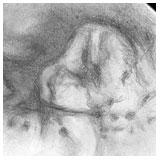 Solis Lacus
Solis Lacus
(Sheehan, 2003) |
 Solis Lacus
Solis Lacus
(Misch, 2003) |
|
In Schiaparelli's 1877 drawings Solis Lacus appears perfectly round, in Barnard's 1894
drawings as oval and crossed by a bright band. In 2003 it appeared very
complex, revealing more or less detail as conditions favored. Sheehan
described it as "a complexly tousled windsock set in the midst of a
boot-shaped area. Some of the winding streaks giving the impression at
times of canals, but only when glimpsed in low powers or poor seeing."
Solis Lacus appeared to Misch to present "a visual center of gravity, more
or less rectangular, from which delicate filaments - the most canal-like
features I saw anywhere on the planet - extended south and eastward, with a
weightier peninsula to the west." In the moments of best seeing, these
general shapes revealed another level of detail, appearing almost maddeningly
complex: full of wisps, streaks, patches, all very irregular. |






